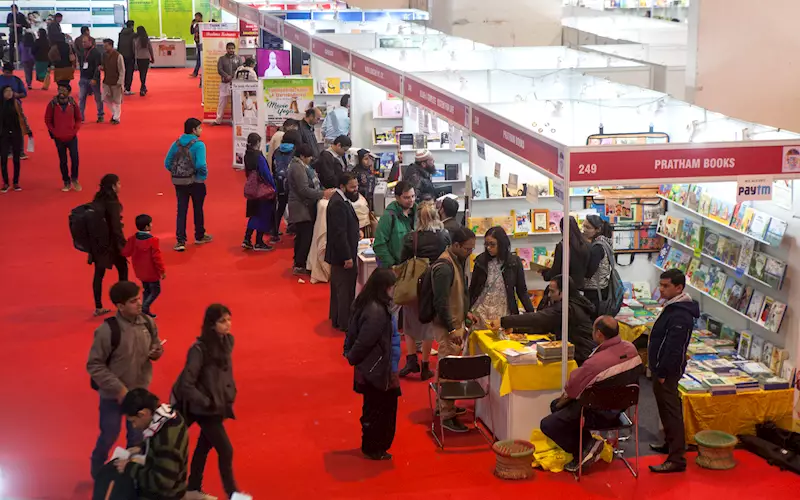For children and reading
Children’s literature has finally come out of the woods. Gone are the days when a story would begin with ‘once upon a time…’ and end with a ‘moral’. Today, children’s literature is more diverse, more colourful, and availability is more widespread. Yet, this is not nearly enough. There is more to be done in the field. According to a survey by Tata Trust, there is one book per five children and one book per 11 children in rural areas. Almost 70% of these are in English and Hindi. PrintWeek India h
15 Mar 2018 | By Dibyajyoti Sarma
Tara Books: Reading pictures
Chennai-based Tara Books publishes illustrated and handmade books for children and adults. While Tara generates many of its titles in-house, it also works with artists, writers and designers across the world. The process of bookmaking is essential to Tara and this is reflected in the dialogue it has with its authors, artists, illustrators and designers. Tara’s handcrafted titles have brought the physical book back into focus in an age busy writing its obituary. It is also the pioneer in bringing artists from India’s folk and tribal communities into the form of the book for the very first time.
Tara’s picture books for children occupy a distinctive place in the global culture of the children’s picture book — experimenting as they do with form, type, illustrations and design. Just as unique are its picture books for adult readers, which respond to a range of content, from political fables to nonsense verse. Several of Tara’s books tell the stories of women artists, and feature women’s art of the everyday — and visually plot their journeys, from household spaces into art and the printed book.
For Tara, the form of the book is as important as its content— and it continues to draw on Asian as well as other traditions of book craft to redefine the boundaries of the book. Each of Tara books uses contemporary design to bring together text and art in special ways. As much as Tara is interested in the visual, it is engaged with visual education, and in creating art activity books that are rich in content yet very affordable.
Pratham Books: Open platform storytelling
Bengaluru-based Pratham Books started with the objective to create affordable supplementary readers in multiple Indian languages and provide access to all children through innovative means. Today, Pratham Books has 375 titles in 20 languages, amounting to total 2,500 books. It has distributed 14 million print books and 16 million story cards. Most importantly, all the books are in Rs 35 to 45 price points.
But this was not enough. There were more than 300 million children yet to be reached. This is where Pratham’s StoryWeaver came to the rescue. StoryWeaver is a digital repository of multilingual stories for children. With this, every child can have access to an endless stream of stories in her mother tongue to read and enjoy.
The result is out there. In September 2015, StoryWeaver had 800 stories in 24 languages. This rose to 6,000 stories in 102 languages by October 2017. Today, StoryWeaver has 430,000 users, 22 million readership and 160,000 downloads.
One of the major push of StoryWeaver is creating material in mother tongue. It has 24 mainstream Indian languages, tribal languages, minority languages, and classic languages, because a range of world languages, from French, German, to Swahili, Zulu, Cantonese, Zech, and Kurdish.
Who reads digital stories? To promote the movement, Pratham has organised active outreach with educators, librarians, not-for-profit organisations across India. It has also roped in schools to the StoryWeaver movement. Today, 34 organisations are using StoryWeaver in 5,200 classrooms across 22 Indian states.
100 Story House: A space for reading
Started by Jemimah LC Marak, an educator and James Nokseng G Momin, teacher, Christian Girls Higher Secondary School, Tura, 100 Story House is a reading library for children based in Tura, Meghalaya, in the North East of India. The library was established with the express aim to promote the habit of reading among children. It also has other agendas, such as reviving the custom of passing down of traditional wisdom and values from elders of the community to the younger generation; to combat negative influences of technology such as mobile phone games, video gaming, etc by providing healthy alternatives to occupy young minds, facilitating a positive and productive environment and providing a platform for local artists to display their art and teach them to children enrolled at the library.
The registered members are the students from the local schools in the age ranging from 5 to 15 years. The activities include art and craft, educational and recreational games, recycling from waste, music, kitchen gardening, etc. The space is open for reading and activities only on Saturdays, from 10 am to 6 pm. However, readers who want to borrow/ return books on weekdays may do so after 5:30 pm. There are also a variety of books for adult readers.
The library also serves as a tuition/ supervised study centre for as many as 30 students from different schools and neighbourhoods. Free counselling sessions are offered and conducted after the tuition classes.
While primarily self-sponsored, the library also receives donations from well-wishers and visitors, including monetary gifts, secondhand and new books, secondhand furniture, wood planks for shelves and paintings and bookmarks.














 See All
See All